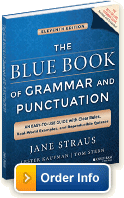|
Welcome to your GrammarBook.com e-newsletter.
|
“I use GrammarBook.com whenever I need assistance with difficult grammar or syntax questions.”
—Georges N.
“I visit your site frequently and always find helpful advice to guide me when producing and editing documents for work in the higher education sector and in my postgraduate studies. Thanks so much!”
—Raquel S.
“Every week I look forward to your
e-newsletter to stimulate my own analysis.”
—Ron P.
|
|
|
The Man Who Hated Semicolons
Ten years ago, the author Kurt Vonnegut stirred things up with four sentences he wrote in his final book, A Man Without a Country: “Here is
a lesson in creative writing. First rule: Do not use semicolons. They are transvestite hermaphrodites representing absolutely nothing. All they do is show
you’ve been to college.”
One must consider the source here. Vonnegut was a world-renowned novelist who had earned the right to make outrageous statements. He was not condemning all
semicolons; he was condemning all pretentiousness.
As Vonnegut well knew, semicolons have at least one legitimate role: to separate items in a series when one or more of the items contain commas. Look at
this mess of a sentence: The conference has people who have come from Italy, Texas, Moscow, Idaho, Venice, California, and other places as well.
How could a reader know that only three specific locations are mentioned? The simple fix is three semicolons: The conference has people who have come from Italy, Texas; Moscow, Idaho; Venice, California; and other places as well. (Yes, Italy is a town in
Texas.)
What Vonnegut disdained was the discretionary semicolon, used by writers to combine complete sentences when a period feels too final, as in this example: I looked at her; she smiled; we danced until dawn. Here the semicolons blend three terse statements into one sentence, which, in the writer’s
opinion, more faithfully evokes the flow of events on that enchanted evening. (Vonnegut would have preferred three short sentences.) Note that there are no conjunctions in the sentence. If the last clause were and we danced until dawn, commas would suffice, and most editors would banish the semicolons.
Fledgling writers especially should be wary of semicolons where commas will do. One wonders what the Vonnegut of 2005 would have said about the following
sentence, written by a twenty-seven-year-old novelist: “Kroner’s belief [was] that nothing of value changed; that what was once true is always
true; that truths were few and simple; and that a man needed no knowledge beyond these truths to deal wisely and justly with any problem whatsoever.”
The young author would defend his semicolons, claiming they give more weight to each clause than a comma could. But many editors would want commas there.
The sentence, by the way, is from Kurt Vonnegut’s first published novel, Player Piano (1950).
Less than twenty years after Player Piano, Vonnegut achieved success beyond his wildest dreams. He had found his voice and streamlined his approach. Taken at face
value, Vonnegut’s writing tip is sound advice—for Vonnegut. Semicolons do not suit the inimitable laconic style he perfected in the sixties, when
he was lionized by the Baby Boomer generation.
Because of the e-newsletter’s large readership, please submit your English usage questions through GrammarBook.com’s “Grammar Blog.” |
|
Semicolons: Pop Quiz
Supply the necessary punctuation. Our answers are below.
1. He was too critical she was not critical enough.
2. Vanitia told me her wishes; a white picket fence a wonderful husband two gifted children and a million dollars in the bank.
3. Vanitia told me her wishes a white picket fence a handsome, successful husband two intelligent, gifted children and a million dollars in the bank.
4. He walked down the street he could not find her he went home feeling hopeless.
5. He walked down the street he caught a bus and it took him home.
Free BONUS Quiz for You!
[[firstname]], because you are a subscriber to the newsletter, you get access to one of the Subscription Members-Only Quizzes. Click here to take a Semicolons and Colons Quiz and get your scores and explanations instantly!
More Good News for Quiz Subscribers
We are pleased to announce that we have added even more quizzes to help you challenge yourself, your students, and your staff. We added quizzes to existing categories and created some new categories such as “Confusing Verbs,” “Subjunctive Mood,” “Comprise,” and “Sit vs. Set vs. Sat.”
We reviewed and strengthened every quiz on our website to ensure consistency with our rules and guidelines contained in the eleventh edition of The Blue Book of Grammar and Punctuation.
If you think you have found an error in a quiz, please email us at help@grammarbook.com.

“So convenient … hundreds of quizzes in one click.”
[[firstname]], Subscribe to receive hundreds of English usage quizzes not found anywhere else!
- Take the quizzes online or download and copy them.
- Get scored instantly.
- Find explanations for every quiz answer.
- Reproduce the quizzes to your heart’s content.
- EASY to use.
- No software to download.
- No setup time.
- A real person to help you if you have any questions!
Instructors and Employers: we make your life easier!
- Assign quizzes to your students or employees.
- Students log in from anywhere.
- Scores are tallied and compiled for you.
- You decide whether to let students see their own scores and quiz explanations.
- Let GrammarBook.com take the hassle out of teaching English!
“Fun to test my skills!”
“The explanations really help … thanks!”
Your choice: Subscribe at the $29.95 or $99.95 level ($30 off - previously $129.95).
“I download the quizzes for my students who don’t have computer access.”
Subscribe today to receive hundreds of English usage quizzes not found anywhere else!
“Makes learning English FUN!”
 |
Don’t need all the quizzes at once?
You can now purchase the same quizzes individually for ONLY 99¢ each. Purchase yours here. |

Get Yours Today!
Get Amazon’s No. 1 Best-seller in Four Categories!
No. 1 in Grammar
No. 1 in Reading
No. 1 in Lesson Planning
No. 1 in Vocabulary |
The Blue Book of Grammar
and Punctuation
by Jane Straus, Lester Kaufman, and Tom Stern
The Authority on English Grammar!
Eleventh Edition Now Available
Have You Ordered Your Copy Yet?
An indispensable tool for busy professionals, teachers, students, homeschool families, editors, writers, and proofreaders.
Available in print AND as an e-Book! Over 2,000 copies are purchased every month!
Order Your Copy Today!
- Hundreds of Grammar, Punctuation, Capitalization, and Usage Rules
- Real-World Examples
- Spelling / Vocabulary / Confusing Words
- Quizzes with Answers
The publisher is extending its pre-publication discount offer until April 30, 2015! If you live in the United States or Canada, order the new edition of The Blue Book
through Wiley.com and get 30 percent off and FREE shipping. Simply go to bit.ly/1996hkA and use discount code E9X4AYY.
For those of you who live outside the U.S. and Canada, although the publisher is not able to offer free shipping, you will get 35 percent off to help offset your shipping costs. Simply go to bit.ly/1996hkA and use discount code E9X4A. |
 Wordplay Wordplay
If you don't pay your exorcist, you get repossessed.
You feel stuck with your debt if you can't budge it.
Every calendar's days are numbered.
Pop Quiz Answers
1. He was too critical; she was not critical enough. OR He was too critical. She was not critical enough.
2. Vanitia told me her wishes: a white picket fence, a wonderful husband, three gifted children, and a million dollars in the bank. (Note the colon after “wishes.” Do not confuse colons with semicolons.)
3. Vanitia told me her wishes: a white picket fence; a handsome, successful husband; three intelligent, gifted children; and a million dollars in the bank. (The commas after “handsome” and “intelligent” make semicolons necessary.)
4. He walked down the street; he could not find her; he went home feeling hopeless. (Or periods.)
5. He walked down the street, he caught a bus, and it took him home.
Learn all about who and whom, affect and effect, subjects and verbs, adjectives and adverbs, commas, semicolons, quotation marks, and much more by just sitting back and enjoying these easy-to-follow lessons. Tell your colleagues (and boss), children, teachers, and friends. Click here to watch. |




 Wordplay
Wordplay
